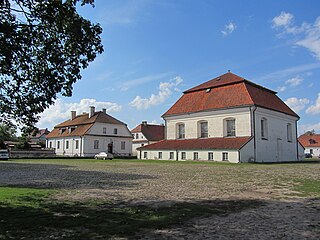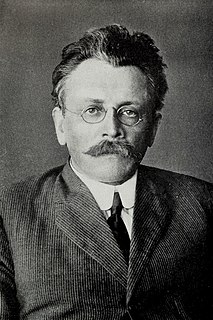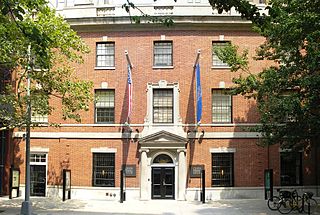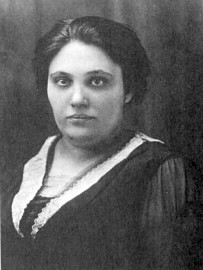
Yiddish is a West Germanic language historically spoken by Ashkenazi Jews. It originated during the 9th century in Central Europe, providing the nascent Ashkenazi community with a High German-based vernacular fused with many elements taken from Hebrew and to some extent Aramaic; most varieties also have substantial influence from Slavic languages, and the vocabulary contains traces of influence from Romance languages. Yiddish writing uses the Hebrew alphabet. In the 1990s, there were around 1.5–2 million speakers of Yiddish, mostly Hasidic and Haredi Jews. In 2012, the Center for Applied Linguistics estimated the number of speakers to have had a worldwide peak at 11 million, with the number of speakers in the United States and Canada then totaling 150,000. An estimate from Rutgers University gives 250,000 American speakers, 250,000 Israeli speakers, and 100,000 in the rest of the world.

The Forward, formerly known as The Jewish Daily Forward, is an American news media organization for a Jewish American audience. Founded in 1897 as a Yiddish-language daily socialist newspaper, The New York Times reported that Seth Lipsky "started an English-language offshoot of the Yiddish-language newspaper" as a weekly newspaper in 1990.

A shtetl or shtetel was a small town with a large Ashkenazi Jewish population which existed in Central and Eastern Europe before the Holocaust. Shtetls were mainly found in the areas that constituted the 19th century Pale of Settlement in the Russian Empire as well as in Congress Poland, Austrian Galicia, Romania and Hungary.

The Yiddish Book Center, located on the campus of Hampshire College in Amherst, Massachusetts, United States, is a cultural institution dedicated to the preservation of books in the Yiddish language, as well as the culture and history those books represent. It is one of ten western Massachusetts museums constituting the Museums10 consortium.

Abraham "Abe" Cahan was a Lithuanian-born Jewish American socialist newspaper editor, novelist, and politician. Cahan was one of the founders of The Forward, an American Yiddish publication, and was its editor-in-chief for 43 years. During his stewardship of the Forward, it became a prominent voice in the Jewish community and in the Socialist Party of America, voicing a relatively moderate stance within the realm of American socialist politics.

Jewish culture is the culture of the Jewish people, from its formation in ancient times until the current age. Judaism itself is not a faith-based religion, but orthoprax, pertaining to deed and practice. Jewish culture covers many aspects, including religion and worldviews, literature, media, and cinema, art and architecture, cuisine and traditional dress, attitudes to gender, marriage, and family, social customs and lifestyles, music and dance.

YIVO, established in 1925 in Wilno in the Second Polish Republic as the Yidisher Visnshaftlekher Institut, is an organization that preserves, studies, and teaches the cultural history of Jewish life throughout Eastern Europe, Germany, and Russia as well as orthography, lexicography, and other studies related to Yiddish. The English name of the organization was changed to the Institute for Jewish Research after its relocation to New York City, but it is still known mainly by its Yiddish acronym. YIVO is now a partner of the Center for Jewish History and serves as the de facto recognized language regulator of the Yiddish language.

Yiddish literature encompasses all those belles-lettres written in Yiddish, the language of Ashkenazic Jewry which is related to Middle High German. The history of Yiddish, with its roots in central Europe and locus for centuries in Eastern Europe, is evident in its literature.

The Jewish Book Council founded in 1944, is an organization encouraging and contributing to Jewish literature. The goal of the council, as stated on its website, is "to promote the reading, writing and publishing of quality English language books of Jewish content in North America". The council sponsors the National Jewish Book Awards, the Sami Rohr Prize for Jewish Literature, the JBC Network, JBC Book Clubs, the Visiting Scribe series, and Jewish Book Month. It publishes an annual literary journal called Paper Brigade.

Jewish American literature holds an essential place in the literary history of the United States. It encompasses traditions of writing in English, primarily, as well as in other languages, the most important of which has been Yiddish. While critics and authors generally acknowledge the notion of a distinctive corpus and practice of writing about Jewishness in America, many writers resist being pigeonholed as "Jewish voices." Also, many nominally Jewish writers cannot be considered representative of Jewish American literature, one example being Isaac Asimov.
Itche Goldberg was a Polish-born Yiddish language writer of children's books, poet, librettist, educator, literary critic, camp director, publisher, fundraiser, essayist, literary editor, Yiddish language and culture scholar, and left-wing political activist. He devoted his life to the preservation of the Yiddish language and secular Yiddish culture.
Donald Weber is a literary critic and a specialist in Jewish American literature and film studies. He is the Lucia, Ruth, and Elizabeth MacGregor Professor of English and Chair of the English department at Mount Holyoke College.
Betty Walker was a Jewish-American actress and comedian who performed primarily during the 1950s and 1960s.

Louis E. Miller (1866–1927), born Efim Samuilovich Bandes, was a Russian-Jewish political activist who emigrated to the United States of America in 1884. A trade union organizer and newspaper editor, Miller is best remembered as a founding editor of Di Arbeiter Tsaytung, the first Yiddish-language weekly published in America, and a co-founder with Abraham Cahan of the Jewish Daily Forward, the country's first and foremost Yiddish-language daily.
Jeremy A. Dauber is the Atran Professor of Yiddish Language, Literature, and Culture in the Department of Germanic Languages at Columbia University, specializing in Yiddish and Jewish literature, American Jewish culture, and American studies.

Stereotypes of Jews are generalized representations of Jews, often caricatured and of a prejudiced and antisemitic nature. Those stereotypes include: Jews always acting with unforgiving hostility towards Christians, Jews' religious rituals which have specifically undermined the Christian Church and state, and Jews' habitual assassinations of Christians as their most extreme deeds.

Jules Chametzky is an American literary critic, writer, editor, and unionist. His essays in the 1960s and 1970s on the importance of race, ethnicity, class, and gender to American literary culture anticipated the later schools of New Historicism and Cultural Studies in American letters. Chametzky was a founder and long-time editor of the Massachusetts Review, an editor of Thought and Action, the journal of the National Education Association, as well as the third President of the Massachusetts Society of Professors, the faculty/library union at the University of Massachusetts. He was also a founding member of the Coordinating Committee of Literary Magazines and its first secretary. Chametzky was married for over fifty years to the writer, editor, and educator Anne Halley (1928–2004).
Judah Leib Cahan, more commonly known as Y.L. Cahan, was a Yiddish folklorist.

Yente Serdatzky was a Russian-born American Yiddish-language writer of short fiction and plays, active in New York City.

Fradl Shtok was a Jewish-American Yiddish-language poet and writer, who immigrated to the United States from Galicia, Austria-Hungary, at the age of 18 or 19. She is known as one of the first Yiddish poets to use the sonnet form; and her stories, which were less well received than her poems in her lifetime, have since been recognized as innovative for their exploration of subjectivity, and, in particular, for their depiction of Jewish female characters at odds with traditional roles and expectations.














